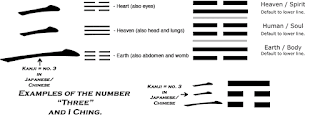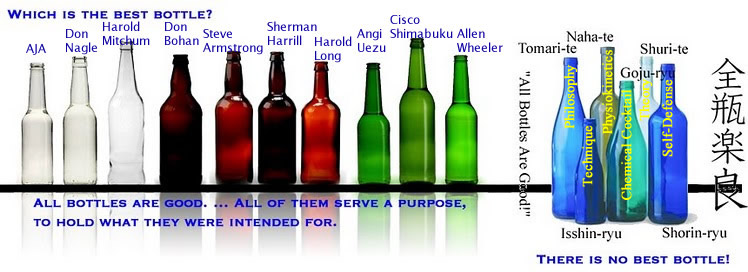In my articles, postings but I like the term article more, I write about all sorts of things from my personal theories, to the physical aspects through principles, sometimes techniques as they apply to methodologies and force levels as well as philosophy, etc. Directly related to karate, the Asian connection if you will, I have noticed a lot of groupings in, “Three’s.”
- Shin-gi-tai (Shin; Gi: Tai).
- Shu-ha-ri (Shu; Ha; Ri).
- Shoshin, Zanshin, Mushin.
- Awareness, Intention and Intent.
- Kihon, Kata, Kumite.
- Heaven, Earth, Humanity.
- Body, Mind, Spirit.
- Serenity, Tranquility, Humility.
- Kata in sections of three.
- Morality, Civility, Honor.
- Humanity, Justice, Courtesy.
- Intent, Restraint, Action.
and so on where the stages of karate and martial disciplines seem to be governed by numerology, particularly the number three, along with other ancient cultural beliefs directly implemented from their society into the study, practice and application of martial disciplines.
Consider this, in the sciences of modern times mathematics are involved in explaining everything in nature and the universe. The code of the Internet is made up of 1’s and 0’s. Since it is often associated with astrology and horoscopes along with ancient studies of the I Ching that utilizes numbers within the selection by throwing a certain number of yarrow sticks or … wait for it, “Three coins.” Look at how we naturally use numbers to list items, to create bulleted items of knowledge that would trigger in-depth thinking, understanding and define those into greater detail. The list is endless and it associates numbers with everything.
Note: obvious traits of the 3 are in the creative field. A powerful need to express feelings, ideas and visions of the imagination; For the 3 to become a well-rounded, balanced and happy person, it must learn discipline; Another unique quality of the 3 is its tendency to be "lucky," or rather, to be in the right place at the right time. This may be connected to its innate sense of rhythm; timing can be measured in seconds or in years, by the beating of a heart or by the movement of the stars. It is all only a matter of scale, either way, the 3 seems to be in tune with the cyclical nature of our surroundings; etc.!
Chinese Culture: The number 3 (三, Pinyin: sān, jyutping: saam1) sounds similar to the character for "birth" (生, Pinyin: shēng, jyutping: saang1), and is considered a lucky number.[citation needed] The number 3 is significant since there are three important stages in a man’s life (birth, marriage and death).
Universally: The universal meaning of three probably relates to man, woman and child—the fulfillment of birth and productivity. As a symbol of fulfillment, three often occurs in fairy tales as the number of tests to be passed or riddles to be solved; Three is a sacred number in most religions. The Ancient Egyptians had a powerful trinity of gods as did the Ancient Greeks and Romans. Hindus worship a trinity known as the Trimurti ("three forms"). Christians believe in a Holy Trinity. In Islam three symbolizes the human soul. To Pythagoras three symbolized perfect harmony, being the sum of unity (one) and diversity (two).
Japanese Culture: there are also numbers that are considered unlucky in Japan. The number four is considered to be unlucky because the word for four is shi (四/し) closely resembles the word for death shi (死/し). Likewise, the word for nine ku (九/く) sounds similar to the word for pain and suffering ku (苦/く). This is why gifts should never be presented in fours, but rather in sets of three or five; To prevent three years of misfortune, those entering their unlucky years will get purified at a temple or shrine; Japan also has special numbers which stand for good luck and bad luck. Lucky Number…8 (Hachi) and 7(Nana) “8” is written as “八” in Kanji. 八 is considered “末広がり(Suehirogari)” from its shape which widens toward the end. Suehirogari is to become more and more prosperous as time goes. Lucky “7” comes from Western culture, and Japanese also likes to choose 7 in any occasion. Unlucky Number…4(yon/shi), 9 (kyu, ku) “4” is pronounced “yon” or “shi” which is used differently depending on things. Especially, the sound “Shi” has the same pronunciation with “死” which means die, so people are in the habit of not using “4” in hospitals and congratulations occasions. “9” is pronounced “kyu” or “ku” which is used differently depending on things. The sound “ku” has the same pronunciation with “苦” which means pain or suffering. So, “49 (yonjûkyu/shijûku)” is a super unlucky number because it means “die with pain”; 3 Treasures – truth/courage/compassion, also the three jewels; From the Buddhist tradition, comes “The Triple Gem” or “The Three Jewels [The Mirror – symbol of truth and wisdom; The Jewel symbol of compassion; The Sword – symbol of strength and courage],” which is the Buddha (the enlightened one), the Dhamma (the teachings), and the Sangha (the community of followers).
More: Body/mind/spirit, which encompasses the physical, mental, and spiritual makeup of a human being; there are 3 primary colors with which it is possible to obtain all the colors; three types of universe: matter, astral (mental or soul) and spirit; three phases of the moon; past/present/future; Taoist: Great Triad: Heaven/Human/Earth.
Science: Three dimensions; We see the number three in many important, fundamental places on the subatomic level and on the cosmic level; there are three main types of stable particles: the proton, the neutron, and the electron. These are the three building blocks of atoms. All solid matter consists of atoms built entirely from these three particles; How many quarks are there in a proton? Exactly three. How many quarks are there in a neutron? Exactly three; there are three dimensions of space: height, width, and depth. There are three main types of matter: gaseous, liquid, and solid. There are three main types of massive objects: planets, stars, and galaxies; there are also three types of natural laws: the laws of physics, the laws of chemistry, and the laws of biology; the number 1836 has in its digits exactly three multiples of the number three: 18, 3, and 6. In fact, when we look at this ratio to seven decimal places, we find that it has six consecutive multiples of the number three; etc.
Ken-po Goku-i: Human (Person), Heaven and Earth; Sun, Moon and blood; Hard, soft, spit; advance, engage and disengage; Body, time and change; Hand, empty, void; Eyes, see, perception; Ears, ability and perceptions. balance, unbalance and gravity.
 |
| Click for readable large view. |



